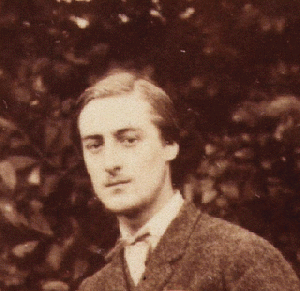
Gerard_Manley_Hopkins_by_Thomas_C._Bayfield - detail-contrast
(Image by The Public Domain Review) Details DMCA
Duluth, Minnesota (OpEdNews) August 16, 2015: I greatly admire Walter J. Ong's densely packed short book HOPKINS, THE SELF, AND GOD (1986), the expanded published version of Ong's 1981 Alexander Lectures at the University of Toronto. In many ways this book is the crowning achievement of Ong's scholarly life.
Recently a Kindle version of it has become available at Amazon.com. As a result, I thought I'd call it to the attention of progressives and liberals who might be interested in it. I understand that the poetry of the Victorian Jesuit poet Gerard Manley Hopkins (1844-1889) may not interest everybody. So the book HOPKINS, THE SELF, AND GOD by the American Jesuit cultural historian and theorist Walter J. Ong (1912-2003) may not interest everybody.
Nevertheless, everybody who has ever suffered near-despair and deep depression might be interested in Hopkins' sonnets about his own experiences of near-despair and deep depression -- and in Ong's discussion of those sonnets.
After all, those progressives and liberals who have not yet experienced near-despair and deep depression may get to have that kind of experience if the Republicans sweep to electoral victories in 2016, eh?
So just in case they do, progressives and liberals might want to know that Hopkins' sonnets expressing extreme anguish are available as resources to read. You see, Hopkins practiced the psychological mantra to feel the feelings, and then he articulated his feelings in those sonnets about his own "dark" experiences of desolation and near-despair. (At other times, he also wrote some upbeat poems.)
Of course both Hopkins and Ong were orthodox Roman Catholic priests. To this day Ong is the only Roman Catholic priest who served as president of the Modern Language Association of America (in 1978). Like Hopkins, Ong had studied Greek and Latin. Both men studied philosophy and theology as part of their Jesuit training.
Disclosure: I myself do not agree with Ong's and Hopkins' orthodox Roman Catholic religious convictions. For example, Ong says, "Jesus acts somewhat as the go'el in ancient Hebrew culture, the reliable and resourceful kinsman whose obligation it was to take responsibility on himself for suffering and helpless relatives, to redeem them from slavery, rescue them from starvation, or otherwise extricate them from disaster. Sin, estrangement from God, brought the greatest disaster of all, and Jesus took sin and its consequences on himself in his life, and especially through his passion and death. He became a human being, kinsman to all of us, to serve as go'el, the responsible one, the one who shoulders the burden of estrangement that his kinsfolk cannot carry" (page 114). No doubt Ong's point here is consistent with the interpretation of the historical Jesus' crucifixion and death that his grieving followers constructed. But the historical Jesus was simply crucified on trumped-up charges. He did not die for the sins of the world. Concerning his crucifixion, see Paula Fredriksen's book JESUS OF NAZARETH: KING OF THE JEWS (1999).
Now, as part of Ong's Jesuit training, he did graduate studies in philosophy and English at Saint Louis University, the Jesuit university in St. Louis, Missouri -- where T. S. Eliot (1888-1965) was born and raised.
Ironically, the young Canadian layman Marshall McLuhan (1911-1980), who was teaching English at SLU (from 1937 to 1944), introduced Ong and other students to Hopkins' poetry. Hopkins' poetry was posthumously published in 1918. McLuhan had done graduate studies in English at Cambridge University, where studied under F. R. Leavis (1895-1978) and I. A. Richards (1893-1979) -- both of whom admired Hopkins' poetry. Leavis discusses Hopkins' poetry in his book NEW BEARINGS IN ENGLISH POETRY (1932). Richards discusses Hopkins' poetry in his book PRACTICAL CRITICISM (1929) and elsewhere.
McLuhan served as the director of Ong's Master's 1941 thesis on Hopkins' sprung rhythm. Ong's Master's thesis, slightly revised, was first published in 1949. It is reprinted in the 600-page anthology titled AN ONG READER: CHALLENGES FOR FURTHER INQUIRY (2002, pages 111-174). However, for a more up-to-date scholarly discussion of Hopkins' sprung rhythm, see James I. Wimsatt's HOPKINS'S POETICS OF SPEECH SOUND: SPRUNG RHYTHM, LETTERING, INSCAPE (2006).
McLuhan completed his Cambridge University doctoral dissertation in English in 1943. On the occasion of the centennial of Hopkins' birth in 1844, McLuhan published "The Analogical Mirrors" in the KENYON REVIEW (1944).
In the NEW YORK TIMES BOOK REVIEW dated September 3, 1944 (pages 7, 14), McLuhan also published a review of Eleanor Ruggles' book GERARD MANLEY HOPKINS: A LIFE. For a more recent life of Hopkins, see Paul Mariani's GERARD MANLEY HOPKINS: A LIFE (2008). Mariani is a seasoned Hopkins scholar. In Ong's 1986 book about Hopkins, he frequently cites an earlier work by Mariani.
Both McLuhan's "The Analogical Mirrors" and selections from Ong's published Master's thesis on Hopkins' sprung rhythm are reprinted in HOPKINS: A COLLECTION OF CRITICAL ESSAYS, edited by Geoffrey H. Hartman (1966, pages 80-88 and 151-159 respectively).
McLuhan's "The Analogical Mirrors" is also reprinted in collection titled THE INTERIOR LANDSCAPE: THE LITERARY CRITICISM OF MARSHALL MCLUHAN 1943-1962, selected, compiled, and edited by Eugene McNamara (1969, pages 63-73).
Ong published a lengthy review essay about that book and McLuhan's years at SLU in CRITICISM: A QUARTERLY FOR LITERATURE AND THE ARTS (1970). Ong's review essay is reprinted in AN ONG READER: CHALLENGES FOR FURTHER INQUIRY (2002, pages 69-77).
(Note: You can view every article as one long page if you sign up as an Advocate Member, or higher).




